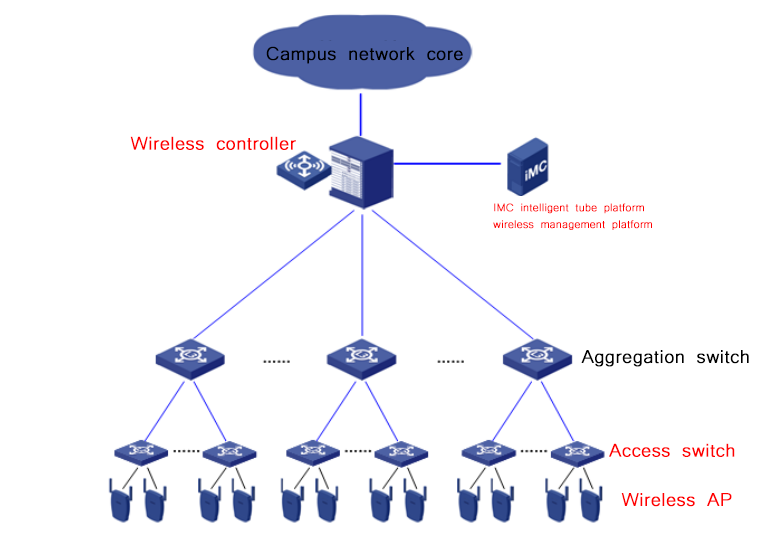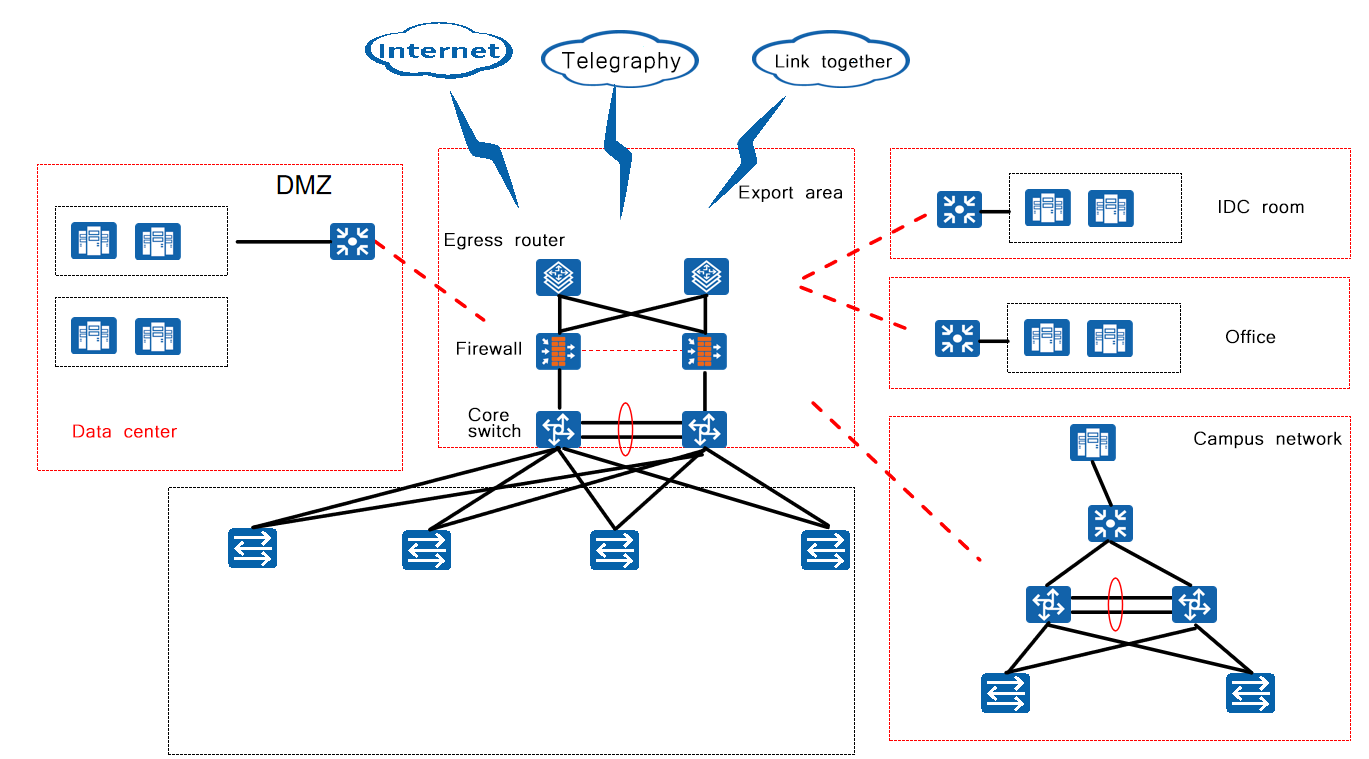














With the rapid development of information technology, the field of education is undergoing a profound transformation. Smart campuses, as an important part of modern education, integrate information technology and educational resources to provide a more efficient and convenient learning and teaching environment for teachers and students. In the construction of smart campuses, the network construction of the cloud computing platform is particularly important.
In the traditional process of educational informatization construction, it is basically carried out according to the principle of "demand-oriented, piecemeal, and independent" construction. Each application system uses independent servers, independent security and management standards, independent databases, and independent presentation layers, that is, a silo-style isolated architecture. It has problems such as high investment, difficult management, low efficiency, high energy consumption, and low availability.
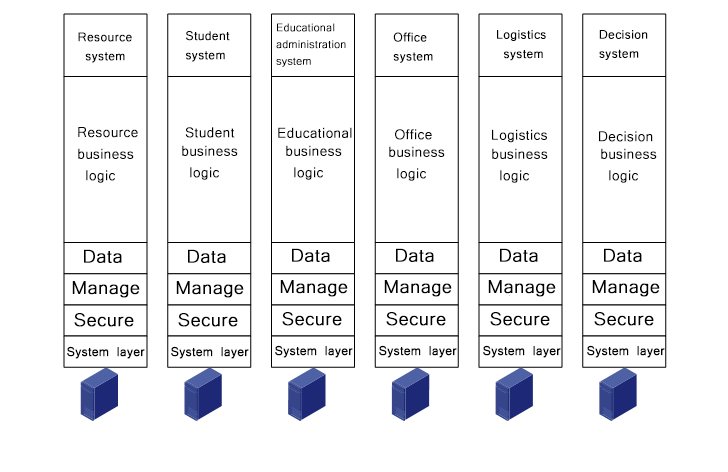
Cloud computing platform is a network-based computing service supply method. It is based on a resource pool that spans heterogeneous and dynamically flowing resources to provide customers with autonomous services, achieving resource allocation on demand and billing by quantity. Cloud computing can promote the scale and centralization of resources, promote further division of labor in the IT industry, and unify the construction and operation and maintenance of IT systems to cloud computing operators, thereby improving the efficiency and flexibility of informatization construction and promoting the intensive level of social and national production and life.
Zhejiang's higher vocational and technical college is a state-owned public full-time ordinary higher school with a history of more than 40 years and covers an area of 1085 acres.
Due to the early construction of its campus network, it adopts the traditional IT construction model. The basic network consists of three-layer physical architecture composed of access, convergence, and core, with a link bandwidth of 100M access and 1000M backbone. Among them, the core switch is a Cisco C6509, and Cisco C4506 is deployed as an access switch for regional convergence in the library, teaching buildings, training buildings, and student apartments; the campus network has two exits, 200M China Telecom and 1000M Education and Scientific Research Network, which are isolated by a gigabit firewall for security; most places on campus have deployed wireless signals, achieving basic coverage of the campus wireless network; the server area currently has 19 servers, mainly 13 servers in service, among which 12 blades of IBM BCH blade servers, 6 blades of physical machines running digital campus network service databases, and another 6 blades deployed for virtualization (Vmware), with a total of 50 virtual machines configured, and 30 virtual machines in operation, with high-end applications of 8CPU/each virtual machine, 8G memory/each virtual machine; data storage is 74T, of which 48T is HP storage and 24T is IBM storage, both are FC SAN.
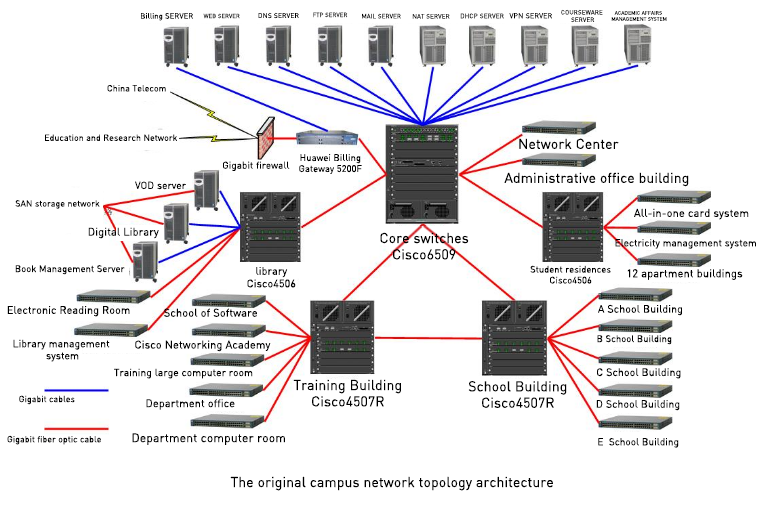
In the early network construction of Zhejiang's higher vocational and technical college, its deployment method is still divided physically according to the application, which may have the following risks and challenges:
Low resource utilization: Since the application is bound to resources, each application needs to be configured according to its peak business volume, which leads to many resources being idle for most of the time. This not only results in low server resource utilization but also creates natural barriers to resource sharing and data sharing.
High operation and maintenance costs: With the addition of new application systems in the school, the number of devices such as servers, networks, and storage will also increase rapidly. Under the traditional data center construction model, it will lead to a sharp rise in space occupation, power supply, heat dissipation and cooling, and maintenance costs, bringing challenges to the school's long-term IT investment and operation and maintenance.
Slow business deployment: Under the traditional model, if the various departments of the school want to deploy new businesses, there is a large delay between submitting change requests and making operational changes. Each business deployment has to go through hardware selection, procurement, installation, operating system and application installation, and network configuration, making the business deployment very slow.
Management policies are scattered: The current IT resource operation and maintenance management lacks a unified centralized IT construction strategy, and it is impossible to monitor, manage, report, and remotely access the infrastructure of the informatization campus network data center, and the IT management strategy is scattered.
With the continuous development of the school, the requirements for key businesses, core applications, and the integrity, reliability, and availability of information data in Zhejiang's higher vocational and technical college are getting higher and higher. Therefore, it is necessary to have a stronger network construction system to maintain efficient and stable network operation.
This plan will start from the development direction and current situation of the informatization direction of the data center of Zhejiang's higher vocational and technical college, strengthen comprehensive coordination and overall planning, and form an integrated and efficient operation with sustainable development capabilities through modern information technology, forming a cloud data center multi-business application platform.
The construction goals of this project are as follows:
Unified management: Through the latest core cloud computing technology, virtualization technology, integrate all existing applications, including WEB, MAIL, FTP, domain control management, OA system, background database, etc., and make unified planning and deployment of the entire business system, unified data backup, to form an effective IT management structure from top to bottom.
Emphasize the scalability and high availability of the overall solution: Use the latest high-performance and reliable servers to ensure the reliability and availability of the entire hardware system and provide reliable hardware protection for users' applications; build a cloud computing platform to play the advantages of the cloud computing platform, provide users with HA functions, ensure the continuity and high availability of users' business systems, and let users' businesses achieve zero downtime risk; provide professional management software to ensure the manageability of the hardware system and software system, and save management investment costs for users.
Based on the above construction goals, on the basis of integrating existing resources, a new cloud computing platform will be built, the backend resources will be pulled through, unified management will be realized, and a three-dimensional security protection system will be constructed to provide a solid foundation for smart campus applications.
The following is the overall architecture of the solution:
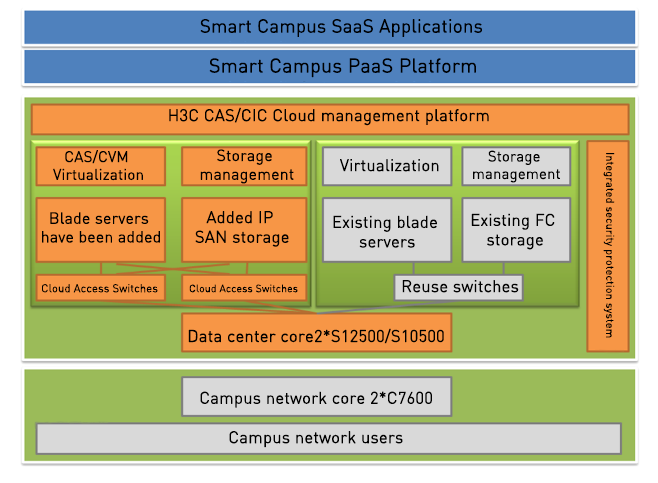
The basic network of this project adopts a "flat" design, with the core layer directly connected to the access layer, eliminating the intermediate convergence layer. With the continuous development of network switching technology, the port access density of switches is also getting higher and higher. The "flat" network architecture can well meet the requirements of the IaaS cloud platform server access of Zhejiang's higher vocational and technical college. At the same time, under the trend of the widespread application of server virtualization technology, the flat two-layer architecture is easier to achieve VLAN large two-layer intercommunication, meeting the deployment and migration of virtual machines. Compared with the traditional three-layer architecture, the flat two-layer architecture can greatly simplify network operation and maintenance.
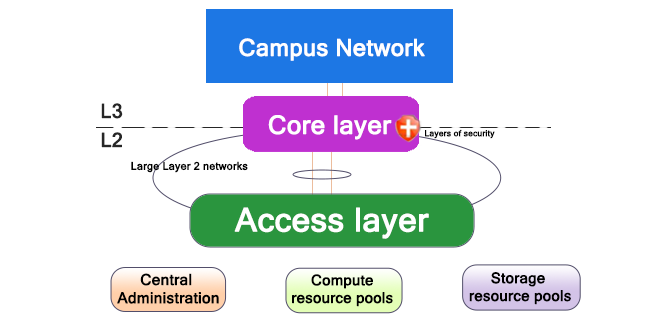
The preferred solution for this small and medium-sized campus local area network construction project is: Cloud Core Switch S125002; Cloud Access Switch S5820v22; Cloud Blade Server FlexServer C80006; Cloud Rack Server FlexServer R3902; Cloud IP SAN Storage HP P45002; Virtualization Platform1; Cloud Management Platform CAS/CIC1; Network Management Platform iMC1. Except for the Cloud IP SAN Storage, all products are selected from the H3C brand.
| Device Name | Recommended Model | Quantity | Configuration Description |
|---|---|---|---|
| Cloud Core Switch | H3C S12500 | 2 | Single engine, redundant network board, redundant power supply; 48-port Gigabit, 8-port 10 Gigabit; Firewall module |
| Cloud Access Switch | H3C S5820v2 | 2 | 48-port Gigabit, 4-port 10 Gigabit, 2-port 40G |
| Cloud Blade Server | H3C FlexServer C8000 | 6 | 1 chassis, 6 dual 6-core blades |
| Cloud Rack Server | H3C FlexServer R390 | 2 | Dual 8-core, 32G memory, 600G hard disk, 4GE |
| Cloud IP SAN Storage | HP P4500 | 2 | 24T SAS disk, 2 * 10G |
| Virtualization Platform | H3C CAS/CVM | 1 | Platform and 12CPU management license |
| Cloud Management Platform | H3C CAS/CIC | 1 | Platform and 100VM management license |
| Network Management Platform | H3C iMC | 1 | Platform and 25-node management license, application management, health |
Upon comparing the effects before and after the transformation of this project, it is evident that the project has led to significant benefits for the school, such as reduced energy consumption, electricity cost savings, and accelerated business processes. The following is a detailed description:
Based on empirical data, a physical server with dual 4-core processors is generally recommended to be consolidated at a ratio of 10:1, meaning that each physical server can run 10 virtual machines. With this calculation, we can consolidate 20 business systems into 2 servers and one set of storage devices. The annual electricity cost is calculated as shown in the table below.
| Cost Item | Before Virtualization | After Virtualization |
|---|---|---|
| Server Quantity (units) | 20 |
3
|
| Storage Quantity (units) | 0 | 1 |
| Power Consumption (kWh/year) |
0.46 × 20 × 24 × 365
|
0.46 × 3 × 24 × 365 + 0.5 × 1 × 24 × 365
|
| Electricity Price (RMB/kWh) | 1 | 1 |
| Annual Cost (10,000 RMB) | 8.06 | 1.65 |
| Annual Savings (10,000 RMB) | 6.41 |
Comparing the power consumption of servers before and after virtualization, it is clear that implementing server virtualization can save up to 79.5% in annual electricity costs, approximately 60,000+ RMB.
In addition to consolidating business systems on servers through virtualization technology, virtual office desktops can also be run on servers to meet the diverse operating system desktop needs of faculty and staff. For instance, the various development and testing environments required by faculty and staff during project development can be conducted on virtual machines. The application and approval process for virtual machines is fully realized through the H3C CAS CIC cloud business management platform.
The deployment speed of new applications has now been accelerated. In practical work, when a new application requires the use of a new server for deployment and testing, it can be carried out within a virtual machine. This significantly reduces the time required for server reconstruction and application loading, thereby improving management efficiency and work productivity.
| Key Task | Before Virtualization | After Virtualization |
|---|---|---|
| Deploy a new business |
|
|
| Hardware maintenance |
|
|
| Migration to virtualization environment |
|
|
In summary, the importance of the smart campus cloud computing platform network construction is self-evident. It not only provides a solid technical foundation for the efficient use of educational resources and personalized teaching but also plays a significant role in data security, teaching model innovation, campus management, and other aspects. In the future, with the continuous advancement of technology, the smart campus cloud computing platform will further promote the in-depth development of educational informatization, providing a more intelligent and convenient educational environment for teachers and students.
